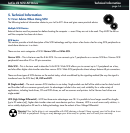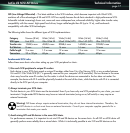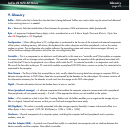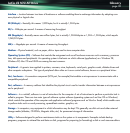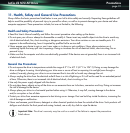
Appendix - SCSI Q & A
page 25
LaCie d2 SCSI AIT Drive
8. Appendix – SCSI Questions and Answers
For the new user, SCSI terminology can be a little daunting. The table below was designed to help you get a clearer
understanding of what the different SCSI names mean and their performance characteristics.
Before you read the chart, let’s define what we mean by Standard, Protocol and Industry names:
• Standard - The broadest category, featuring general guidelines given by the various industry groups and standards associ-
ations. There are three SCSI standards: SCSI-1, SCSI-2 and SCSI-3.
• Protocols – Sub-categories of SCSI standards with defining specific characteristics and features. "Narrow" and "Wide", for
example, tell us about the bus width of a particular type of device.
• Industry names – Names used by computer hardware manufacturers to describe SCSI devices to potential buyers.
Standard Protocols Industry Names Bus Width Signaling Throughput
SCSI-1 "Regular" SCSI SCSI-1, SCSI Narrow (8-bit) SE/HVD Up to 5MB/s
SCSI-2 Wide SCSI Wide SCSI-2 Wide (16-bit) SE/HVD to 10MB/s
Fast SCSI Fast SCSI-2 Narrow (8-bit) SE/HVD to 10MB/s
Fast Wide SCSI Fast Wide SCSI-2 Wide (16-bit) SE/HVD to 20MB/s
SCSI-3 Ultra SCSI Fast-20 SCSI Narrow (8-bit) SE/HVD to 20MB/s
Wide Ultra SCSI Fast-20 Wide SCSI Wide (16-bit) SE/HVD to 40MB/s
Ultra Wide SCSI
Ultra2 SCSI Fast-40 SCSI Narrow (8-bit) LVD to 40MB/s
Narrow Ultra 2 SCSI
Wide Ultra2 SCSI Wide Fast-40 SCSI Wide (16-bit) LVD to 80MB/s
Ultra 2 SCSI
Ultra2 Wide SCSI
Ultra3 SCSI Fast-80 SCSI Wide (16-bit) LVD to 160MB/s
Ultra 160 SCSI Ultra 160/m SCSI Wide (16-bit) LVD to 160MB/s
Ultra 160+ SCSI Wide (16-bit) LVD to 160MB/s
Ultra320 SCSI Ultra4 SCSI Wide (16-bit) LVD to 320MB/s
Fast-160 SCSI
What issues are involved when mixing Narrow SCSI and Wide SCSI devices on the same SCSI chain?
The simplest SCSI configurations use only Narrow devices, or only Wide devices. In this type of configuration, you choose the
correct cable, connect all of the devices in a bus topology, and place the appropriate type of termination at both ends of the
bus. In this case, termination is relatively straightforward because all of the devices have the same width.



